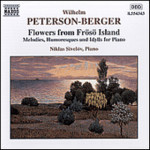
Flowers from Froso Island
 $25.00
Out of Stock
$25.00
Out of Stock6+ weeks add to cart
WILHELM PETERSON-BERGER
Flowers from Froso Island
Niklas Sivelov (piano)
[ Naxos / CD ]
Release Date: Saturday 22 September 2007
This item is currently out of stock. It may take 6 or more weeks to obtain from when you place your order as this is a specialist product.
Wilhelm Peterson-Berger was born in 1867 in Ullånger on the Ångermanland coast in northern Sweden, and spent his school years north of there on the Västerbotten coast. He inherited his musicality from his mother, his first musical experience coming as a seven-year old, while listening enraptured to his mother playing Beethoven's Moonlight Sonata one evening. Thus was born his passion for sitting at the piano, improvising and composing.
Later it would be another part of northern Sweden that he was especially drawn to: Jämtland, with its mountains bordering Norway to the west. It was there, from the house in the rustic manner he had built on the island of Frösö, that he claimed to have the world's most beautiful view, looking out over the waters of Lake Storsjön. Completed in 1914, he called his little part of paradise Sommarhagen ('Summer Refuge') and in 1930 it became his permanent home. The countryside of northern Sweden remained his most important source of inspiration.
Peterson-Berger made the first, decisive, visit to Jämtland in the late summer of 1889. In the following years he spent several weeks each summer hiking in the mountains with other young outdoor-enthusiast friends, always carrying a notebook and some manuscript paper with him. He rehearsed several of his newly composed songs with these friends, thus giving their first performances in the mountain sunshine under an open sky.
In autumn 1895 Peterson-Berger moved to Stockholm and was employed on the leading Swedish daily Dagens Nyheter. Through his honest but often biting music reviews he became one of the most read journalists on Dagens Nyheter, arousing, however, much hostility and jealousy in the process. This in turn led to difficulties for him as a composer. He wanted to be known as a composer of large-scale works, but of his five symphonies only No 3, Same Ätnam ('Lappland'), and of his six larger music dramas only Arnljot, were accepted by the Swedish music establishment Peterson-Berger had to remain in the shadow of his contemporaries Hugo Alfvén and Vilhelm Stenhammar.
It was above all through a number of smaller piano pieces, romanser (the Nordic equivalent of Lieder) and choral pieces that Peterson-Berger came to be cherished by the Swedish public. Even fifty years after his death he can still be regarded as the most popular of all Swedish classical composers. His breakthrough came in 1896 with the publication of Eight Melodies for Piano, entitled Frösöblomster ('Flowers of Frösö'). Certainly it was clear that Grieg's Lyrical Pieces had served as a model and one can glimpse other, even older composers in the background, especially Schumann. But already Peterson-Berger's style is clearly defined, his melodies expressive, his harmonies fresh, often idiosyncratic and his rhythms lithe.
Tracks:
Frosoblomster (Froso-Flowers), Book 1, Op. 16
Frosoblomster (Froso-Flowers), Book 2
Frosoblomster (Froso-Flowers), Book 3